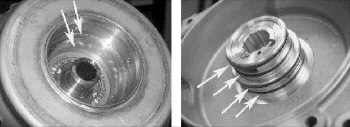Some customers may complain of shift flare when shifting from second gear to third gear. This bulletin contains procedures for diagnosing and repairing this condition. New, improved parts are listed in the Parts Information section of this bulletin.
Affected vehicles: 1997-2002 Mirage, 1999-2005 Galant, 2000-’05 Eclipse, 2001-’04 Diamante, 2001-’05 Eclipse Spyder, 2002-’05 Lancer, 2003-’05 Outlander, 2004 Lancer Sportback Wagon and 2004-’05 Endeavor
Procedure:
1. Test-drive the vehicle to confirm that shift flare occurs at the 2-3 shift.
2. Check the ATF level and color. Correct as necessary. Inspect the A/T drain plug for metal debris.
3. Start the engine and warm the ATF to 140-212° F (60-100° C). With constant throttle opening at TPS reading 1.7-1.8V, confirm that the 2-3 upshift occurs between 35 and 40 mph (between 56 and 64 km/h). Continue this driving pattern until the 2-3 shift has occurred five times.
a. If the shift flare is not eliminated after the 2-3 shift has occurred five times, continue with Step 4.
4. Check for DTCs.
a. If any DTC is set, diagnose the DTC as described in the appropriate service manual.
b. If no DTCs are set, perform the pressure tests for the OD clutch and second brake as described in Group 23 of the appropriate service manual. Record the pressures on the repair order. Then continue with Step 5.
5. Open the rear cover. In the seal ring area, inspect the drum, seal rings and rear cover for grooves, excessive damage and poor clearance. See Fig. 1.

Note: Perform this inspection/repair with the transmission assembly in the vehicle.
a. If any grooves, damage or clearance problems are found, replace the following parts with the new, improved parts listed in the Parts Information chart at right.
– Reverse/OD Clutch Assembly (with drum)
– Reverse Retainer
– Seal Rings
– Rear Cover
– Input Shaft Rear Bearing
b. If no grooves, damage or clearance problems are found, follow the diagnosis procedure in Group 23 of the appropriate service manual.
PARTS INFORMATION
Part Model Part Number
Reverse/OD Clutch Assembly Mirage 1.5L 2722A020
Mirage 1.8L 2722A019
Rear Cover Mirage 1.5L, 1.8L MD763204
Reverse/OD Clutch Assembly Diamante 2722A017
Rear Cover Diamante MD763194
Reverse/OD Clutch Assembly 1999-2003 Galant 2.4L 2722A019
1999-2003 Galant 3.0L 2722A017
Rear Cover 1999-2003 Galant 2.4L MD763204
1999-2003 Galant 3.0L MD763194
Reverse/OD Clutch Assembly 2004-’05 Galant 2.4L 2722A019
2004-’05 Galant 3.8L 2722A023
Rear Cover 2004-’05 Galant 2.4L MD763204
2004-’05 Galant 3.8L MD763194
Reverse/OD Clutch Assembly Eclipse/Eclipse Spyder 2.4L 2722A019
Eclipse/Eclipse Spyder 3.0L 2722A017
Rear Cover Eclipse/Eclipse Spyder 2.4L MD763204
Eclipse/Eclipse Spyder 3.0L MD763194
Reverse/OD Clutch Assembly Lancer/Sportback/Outlander 2722A019
Rear Cover Lancer/Sportback/Outlander MD763204
Reverse/OD Clutch Assembly Endeavor 3.8L 2722A017
Rear Cover Endeavor 3.8L MD763194
Seal Rings All vehicles listed above MD760146, MD760147
Input Shaft Rear Bearing All vehicles listed above MD752039 or MR446687
Courtesy of Mitchell 1.













